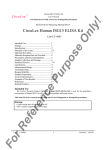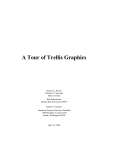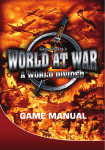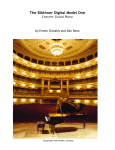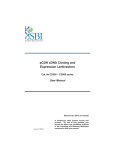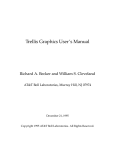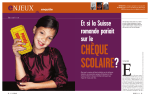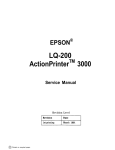Download DNA Groove Templates
Transcript
DNA Groove Template Collections 0206_SDx9Evdb Real pa r t 0206_SDx45Evdb 0206_SDx12Evdb T im e User Manual Volume 1 R&B Collection Volume 2 Pop/Rock Collection Volume 3 Jazz Collection What is feel A Brief Background on the DNA Groove Template Concept All musicians have their own individual styles of playing. A C-major scale played by two different musicians contains many differences in rhythm and dynamics. Some musicians have a distinctive way of playing melodic/rhythmic phrases. There are subtle distinctions that some musicians impart to music phrases that change dynamically over the course of a performance. The entire mix of conscious and sub-conscious articulation that musician possess is called their feel. Musicians develop their feel through experience and interplay with other musicians. A musician who spends many years playing with a jazz ensemble invariably develops a Jazz feel which is different and easily distinguishable for example, from a Rock musician or Classical Musician. An ensemble that has played together for years develops a composite feel, to which each musician contributes his/her particular feel. This feel is not easily transported. For example, most Opera singers will not make great Pop singers. They have tunes their vocal feel for Opera. Great Rock musicians may not necessarily be able to translate their talent into a definitive Reggae style. But great feel is instantly identifiable. When we hear it, we recognize it and we feel it. Great feels move us, they gives music emotions, character and substance. They compel us to listen. Since the advent of sequencers and drum machines, this fundamental, essential and defining aspect of music has been sidelined by a phenomenon called Quantization. Quantization Quantization is the process where notes are moved into precise rhythmic patterns, based on exact sub-divisions of the bar. This eliminates any rhythmic “inaccuracies” in a performance and aligns all the notes to a mathematically defined rhythmic grid. Quantization has become a formidable fixture in sequencing.and is used extensively. Primarily, it saves time. Many years ago when musicians had to play music directly onto multi-track tape, they had to get it right. When they didn’t, they had to retake the passage several times and resort to punching in. It could be very time consuming to get a complicated musical passage recorded right. With quantization, most musicians can complete most of their work within one or two takes. This has dramatically reduced the length of time it takes to record a song. Quantization also allows all the musicians to produce perfectly timed music. However it has resulted in a universal feel and a precision all musicians can easily attain with their midi sequencer. The problem with submitting your creative process to this rhythmic standardization is that quantized music has no distinctive rhythmic character, no real feel. All the notes are aligned perfectly to the ever present quantize grid. The only inaccuracy that enters into the picture is whatever MIDI delay is caused by a particular sequencing system. Groove Quantization Groove Quantization allows for the movement of notes based on a user defined grid. This means that each point in the grid can be precisely defined in the number of clock pulse (ticks) ahead or behind each quantized point each note should be. Most Midi sequences in the mid nineties implemented the groove template feature in their programs. These offer musicians tremendous potential for individual expression. A composer can design a particular rhythmic signature and apply it to music For example, shuffles can have different strengths at different points of the groove “loop”. Several visual representations of Bernard Purdie famous shuffles are included on the following page. Note that the last graph is a drum machine playing a shuffle. Which do you think sounds better ? To create a certain feel, it is not uncommon for sequencer users to move notes individually. Sometimes a suitable quantization grid cannot be found to match the groove of the drum loop. Applying a DNA Groove templates is the fastest and most efficient way to match a feel. As most midi sequencers provide this feature, musicians can now develop a library of grooves to suit many musical situations. DNA Groove Templates Designing a groove template from scratch can be a hit and miss affair. If you know from past experience exactly where each grid point should be, then you can easily create a template. You can use the create template feature (available on most midi sequencers) to design very obvious rhythmic signatures, like shuffles, lags, etc. However, beyond this it is difficult to know where to place each grid position. With DNA Beat Blocks, we created templates that are based on actual acoustic performances, that already have “proven” feels. The timing of each pulse is extracted and provided in the form of a quantized template. All the DNA groove template are two bars long. The purpose of the DNA grooves is not simply to reproduce original music exactly. DNA grooves represent the human touch that makes live music interesting and compelling. DNA grooves bring the feel of live music into the realm of MIDI sequencing. It provides the fastest and the most convenient way to humanize your sequences. DNA Groove Templates as they relate to Drum Loops Includes an analysis of a Phil Collins Drum Groove What follows is a discussion of groove templates and how to apply them as a tool to humanize midi sequences. An analysis of timing of a drum performance by Phil Collins is included to illustrate the complex subtitles of real word acoustic performances. To help generate this subtle feel most midi sequencers have added a groove quantize feature to their programs to assist the midi composers in duplicating the element of human feel. Rather than simply quantizing or playing sequences in perfectly an alternative is available through Numerical Sound and WC Music Research, it is a type of groove template based on real world performances called DNA Grooves Templates. Sequencing History As sequencers evolved in the late 80's the timing resolution as defined as the number of clicks per quarter notes rose from 24 and 96 clicks to 192,384 and 480. This was truly a breakthrough, allowing individual style, feel, and the groove of a musician to be recorded with greater accuracy. Even with this higher resolution, most users, acclimatized by now to the rhythmic perfection of the drum machine, still quantized. Quantization had become an absolute necessity in sequencing. The bottom line was convenience. It reduced the number of takes an average musician had to make to one or two. This time saving factor entrenched quantization into the core of the sequencing process in the 80's. Musicians were given two stark choices, to quantize the performance or play it in right in one or two takes. By the late 80's and early 90's many musicians started to look for other ways to incorporate feel into their midi compositions. One popular technique was the use of drum loops in midi sequences via a sampler. What was interesting is that most of the popular drum loops were real acoustic performances pre the drum machine era (before 1978). There were several factors that helped contribute to the widespread use of resampled acoustic material - especially drum loops. The timing in a drum loop is not quantized but has small signature variations in the timing of each drum element The need for an alternative to quantization became even more apparent as sampled acoustic drum loops were mix in with midi sequences. What Are DNA Groove Templates Groove Quantization allows for the movement of notes to a predefined grid. Each point in the grid is defined as the number of clock pulse (tiks) ahead or behind the groove event is relative to the quantized point. To create a certain feel , it is not uncommon for a composer to move notes individually. Applying a DNA groove template is an efficient way to create a feel. It's feel is "real" because it is based on real human performances. For example if you want to create a feel with Beat 2 being late by 20 ticks and beat 4 to be early by 15 ticks then create a groove template with these qualities. Regardless of how the drum track or any other parts are played in if you apply your groove to the snare and say bass parts then all the bass and snare beat 2 events that exist will be late by 20 tick and the all the beat 4 events will be early by 15 ticks. Groove Example The first 12 bars of the Phil Collins song "Just Another Story" from his CD Dance Into The Light was sampled into the computer. The first 2 bars are shown in fig 5. The loop is then processed with a proprietary process to expose its rhythmic foundation as you can see in Fig. 6. This process is done for each instrument in this example the hihat, snare, kick and bass. The result is a precise series of timing points for the rhythm. The combination of this series of points for each instrument (drum kit and bass) represents the groove part of this song. If we graph a quantized performance it would simply be a straight line along the horizontal axis, however, real performances have an incredible variety of timing variations as you can see from the Figs 1 to 4 from the first 12 bars of the Phil Collins drum performance. The vertical axis has the timing variation in units of a 1000 per beat or quarter note. Thus the downbeats would be 1000 2000 3000 .. to 48000 . If you include 16th notes then the sequence would be 1000 1250 1500 1750 2000 2250 ... If Collins' snare plays behind the beat at 2020 units then the timing shown on the vertical axis on beat 2 is 20. If he plays ahead of the beat at 1940 the value at that point is -60. The graphs illustrate the timing difference relative to the quantized points. To calculate the timing in sequencer ticks simple multiply (ppqn/1000)*value from the graph. If you sequencer has 480 ticks per quarter note then 20 units late would result in 20*(480/1000)=20*0.48=9.6 ticks late. This section of music is composed of 12 bars of 4/4. The tempo per quarter note is 84.858 bpm, resulting in every quarter note being 0.707 seconds long. As you can tell by observing the feel charts there are specific timing or feels patterns with different patterns for each instrument. Look at the hihat in fig 1 with its overall shape of a beginning, middle, and end. A clear graphic representation of a music phrase. Timing is an very important element used by great musicians in their performances. Also notice that each instrument's (fig 1-4) feel chart has its own unique feel pattern and no two are the same. Another very important feature in this groove is when two drum sound are played together. For example, the kick and hihat or the snare and hihat, show small timing difference between there attacks (typically 10-30 milli seconds). The hihat is noticeably and consistently behind the beat and the snare is closer and tighter to the beat, the kick is ahead of the beat and also closer to the beat. The kick and snare are closer to the metronome beats but rarely conflict with each other because they are seldom played simultaneously. I have seen similar characteristic in other great drummers such as Bernard Purdie and Clyde Stubblefield. When the attacks of two drum sounds happen simultaneously they fight (flange). If they are not precisely played simultaneously then each attack can breath and is not unduly infringed upon by each other. Notice in the feel chart of the hihat that there is a shape which it is not a smooth shape there are plenty of micro details. Great drummer such as Phil Collins do this on the fly. To recreate this feature almost every midi note must be edited. Note if the next 12 bars were analyzed they would have similarities with the previous 12 bars but would also have some different timing features. So no copying and pasting midi sections if you want an acoustic feel in your composition. Although subtle timing is important the strength at which the drummer hits the drums also effects the outcome. A lighter touch gives a different sound to the drums. When the snare and hihats are hit to hard they go into overdrive, meaning they have stronger low frequency components and the transient of each hit lasts longer. Playing forte increases the likelihood that the various transients will fight with each other for space. Using samples played softer. It will help your music breath especially in busy or complex passages. This analysis of a passage from a Phil Collins' "Just Another Story" illustrates the vast amount of subtle timing detail evident in any good acoustic performance. To apply these acoustic traits to your midi sequence use DNA groove templates. They can be used to adjust the feel of any midi instrument. Apply a different groove template on to each instrument of your song and change them subtly through the course of your song (no wholesale copy and pasting sections of music). For the hihat track apply a groove then shift the track a couple of ticks to simulate the behind the beat hihat feel as in fig. 1. Make sure that instruments do not fight with each other because of similar attack times, especially if they occupy similar parts of the music spectrum. For example if you add a tambourine to a track with a hihat already playing 16th notes then apply a harder shuffle and a different groove to the tambourine so that each sound can blend and coexist with the other. Creating a Groove Template The timing ratios of each drum element and bass (fig 1-4) are used to create each groove template(s) . Often not all the events of a groove are defined some 16th or triplet notes are missing due to this a further analysis of the groove timing parameters is done and the missing notes are filled in with a consistent feel. Once a groove template is created then a user can access the feel of a real acoustic performance by applying various grooves to various passages of his/her music. G r oo v e T im i ng o f t h e HiH a t i n Ph il C o lli ns Ju st A no t he r St or y Negative is ahead of Q Point Pos itive is later 40 30 20 10 0 -10 0 16 32 48 64 80 96 112 16 t h n ot e e v e n t c ou n t for 48 be a t s 128 144 160 Fi g. 1 176 192 Negative is ahead of Q Point Po sitive is lat er G r oo v e T im i ng o f t he S na r e in P hi l C ol li ns J us t A no t he r St or y 60 40 20 0 -20 -40 -60 0 16 32 48 64 80 96 112 16 t h n ot e e v e nt c ou n t f or 48 be a t s 128 144 160 Fi g. 2 176 192 Negative is ahead o f Q Point Pos it ive is later G r oo v e T im i ng o f t h e K ic k in P hil C o ll in s J us t An ot h er S t o ry 20 10 0 -10 -20 -30 -40 -50 0 16 32 48 64 80 96 112 16 t h n o t e e v e n t c ou n t f or 48 b ea t s 128 144 160 F i g. 3 176 192 Neg at ive is ahead of Q P o int Pos itive is later G ro o v e T im i ng o f t h e B a s s in P hi l C ol li ns J us t A no t he r St or y 60 40 20 0 -20 -40 -60 1 0 16 32 48 64 80 96 112 1 6t h n ot e e ve n t c ou n t f or 4 8 be a t s 128 144 160 F i g. 4 176 192 Orig g in al W ave fo rm in P hi l Co ll ins so ng g J ust A no th er Sto ry y 0 Sam ple A mplit ude 0.5 -0.5 -1 0 1 2 Se con d s 3 Fi g. 5 4 5 5.65 D NA Wa v e fo r m i n Ph il C o ll in s s o ng J us t A no t her St or y 0.3 Samp le A m plitu de 0.2 0.1 0 -0.1 -0.2 -0.3 0 1 2 Se c on ds 3 F i g. 6 4 5 5.65 DNA Groove Template Terminology Pulses and Beats A bar of 16th notes are made up of 16 events called pulses. A beat is defined as the pulses at the quarter note positions. For example, in a 16th note template, every 1,5,9,13,17,21,25,29 position are beats, all other points are considered pulses. The first 16th note after the downbeat is called P2. The next pulse is P3 (the 8th note position) after the downbeat and the 16th note before the next downbeat is called P4. P1 is the downbeat. The Beats in a one bar phrase are B1 B2 B3 B4. B2 B1 B3 P1 P2 P3 P4 P1 P2 P3 P4 B4 B1 B3 P1 P2 P3 P4 P1 P2 P3 P4 P1 P2 P3 P4 B2 B4 P1 P2 P3 P4 P1 P2 P3 P4 P1 P2 P3 P4 Notes Modified by the DNA Groove Templates When a groove template states Move B2 & B4 it implies B2 & B4 in both of the two bar patterns (B2,B4,B6,B8). When a groove operation states that it Moves Pulse 2&4 (P2,P4) it is primarily the P2 and P4 note in all the beats of a user selected passage of music (to be grooved) which is moved. These pulses are moved to the predefined Groove Template Points. Groove File Naming System If the Groove File Name contains ends in [Name]p.Grv then the groove file is a Pulse Motion File. If the Groove File Name has [Name]b.Grv then the groove file is a Beat Motion Groove. Contents of Each DNA Groove Template Each Drum Loop on this CD contains two types of DNA groove files. The first set is called the Pulse Motion, which primarily processes pulses. The second is called Beat Motion which primarily processes Beats. In some grooves the Pulses sometimes affect the Beats and vice versa. Pulse Motion Beat Motion Original Move P2 Pulse Motion Move P2 This is the set of DNA Move P3 Grooves variations that Move P3 primarily process the Move P4 three 16th notes Move P4 between each beat. Move2&3 Move23&4 Move23&4 ShflS2&4 ShflM2&4 Shuffles ShflH2&4 ShflS2M4 ShflM2S4 ShflM2H4 Original Move B1&2 Move B1&3 Move B1&3 Move B1&4 Move B2&3 Move B2&3 Move B2&4 Move B2&4 Move B2&4 Move B3&4 Move B3&4 Move All 1 Move All 2 Move All 3 Move All 4 “Original” is the syncing groove, which is meant to lock other midi events to the drum loop as heard on this CD. Note that your sequencer must re-trigger this audio loop every 2 bars and the tempo must be the same as listed in this user manual. Beat Motion This is the set of DNA Groove variations that primarily process the quarter notes. The pulse often move slightly in order to retain the balance in the groove. Groove Abbreviations 1 2 3 4 5 6 7 8 9 10 11 12 13 14 15 16 17 Groove Name SoftShfl Soft Shuffle SfMdShfl Soft Medium Shuffle Med_Shfl Medium Shuffle MdHdShfl Medium Hard Shuffle HardShfl Hard Shuffle EarlySnr Early Snare (Beats 2 &4) LateSnr Laid Back Snare (Beats 2 &4) EarlyBt2 Early Beat 2 LateBt2 Late Beat 2 EarlyBt4 Early Beat 4 LateBt4 Late Beat 4 EarlyKik Early Kick (Beats 1 & 3) LateKik Laid Back Kick (Beats 1 & 3) DriveFill Driving Fill LaggFill Lagging Fill AltVelocity Alternate Velocity DNA Groove Templates “A Quick Overview” DNA Grooves are 2 bar quantize maps derived from real music. The rhythmic character is analysed and stored as a groove template. Use the templates to groove quantize midi data. This will often result in a dramatic transformation in your music. Groove quantization works very much like normal quantization except, notes are moved according to the rhythmic map of the template instead of a basic mathematical formulae. The execution is very simple, first play a sequence into your midi sequencer. Select a region of this new performance, then select the desired groove template and finally listen to the results. The R&B, Rock and Jazz collection each contain 10 groove files. Each groove file has 17 groove templates, all of which share a similar attitude or feel, but are designed to influence different parts of your music. The Variations To create a great feel in your sequencer apply a different template from the same groove file to different tracks in your sequence. For example, put the first groove on the Kick, a Late Snare variation on the snare and a Medium Shuffle on the HiHats. In general, use templates from one groove file for each of your songs. All templates in a file were derived from the same music, so they will work harmoniously together. Shuffles A shuffle delays every second 16th note by a certain amount. Because DNA Grooves are derived from real music the amount varies slightly from beat to beat. The Soft shuffle results in the smallest delay while the Hard Shuffle results in the greatest dely. Shuffles will have little effect on music containing no 16th notes. A Soft & Medium shuffle means that the first half of each beat is shuffled by a smaller amount (2nd pulse after the downbeat) than the second (4th pulse after the downbeat). Snare & Kicks Early/Late Snare moves the beats 2 & 4 positions of each bar early or late. Early/Late Kick moves the beats 1 & 3 position early or late. The pulses are also shifted somewhat so that the rhythm sounds consistent. Fills Fills concentrate most of there impact in the second bar of the template. This is meant to simulate the rushing or lagging feel one hears at the end of a section or passage of music. Timing Adjust the timing (sensitivity) to control the amount of grooving you want to apply. Velocity The DNA Grooves often encode velocity information as well as timing. The first 16 templated in each groove file share the same velocity map. The Alternate Velocity (17 Groove Template) is a different velocity map. The Feel Charts The charts on the following pages graphically illustrate the feel of the first groove in each groove file. The vertical axis shows the displacement, in clock pulses (960 ticks per quarter note resolution). Most of the grooves have 32 events (2 bars of 4/4 with sixteenth note resolution). A line below the horizontal axis is later that the quantized point and a line about is a note ahead of the quantized point. A Feel Chart with all the notes quantized 1 0.5 If an event is ahead of the quantize point then it’s line is in this quadrant 0 If an event is behind (later) the quantize point then it’s line is in this quadrant -0.5 -1 0 4 8 12 16 Time 20 24 28 32 R&B Grooves Feel Charts 20 15 10 5 0 -5 -10 0 4 8 12 16 20 24 31 Timedouble undulating push. 11 Apple Pie - Straight feel with 20 10 0 -10 -20 -30 0 4 8 12 16 20 24 31 Time 12 Boogie On - Hybrid mixture of straight and half- shuffle. 20 10 0 -10 -20 -30 -40 0 4 8 12 16 20 24 31 Time 13 Funky Drum - Hybrid mixture of lags and soft shuffles. R&B Grooves Feel Charts - continued 0 -20 -40 -60 -80 0 4 8 12 16 20 24 31 Time 14 Keep Truck - Medium to hard shuffle with lagging down 4 8 12 beats. 30 20 10 0 -10 -20 0 16 20 24 31 Time 15 Let’s Get On - Straigh stable pushing feel that is gener- ally ahead of the beat. 30 20 10 0 -10 -20 -30 0 4 8 12 16 20 24 Time 16 Love Kid - Straight even straddle with a slight soft shuffle. 31 R&B Grooves Feel Charts - continued 20 10 0 -10 -20 -30 -40 0 4 8 12 16 Time 20 24 31 17 Manchuria - Straight gradulating lag over each beat. 40 20 0 -20 -40 -60 -80 0 4 8 12 16 20 24 31 Time 18 Mercy - Medium shuffle with some pushing down beats. 4 8 12 40 30 20 10 0 0 16 20 24 Time 19 Reflection - Straight single undulating push. 31 R&B Grooves Feel Charts - continued 20 0 -20 -40 -60 -80 -100 0 4 8 12 16 20 24 20 SuperStich - Hard shuffleTime that lags behind the beat. 31 Pop/Rock Grooves Feel Charts 60 40 20 0 -20 -40 -60 0 4 8 12 16 20 24 31 Time 21 Fool Rain - Medium shuffle with early downbeats with a reduction in shuffle intensity at the begining of bar 2. 60 40 20 0 -20 0 4 8 12 16 20 24 31 22 Give It - Straight constantTime push with early downbeats. 20 0 -20 -40 -60 -80 0 16 20 24 31 Time 23 Heart Break - Hard lagging shuffle that tightens every two bars. 4 8 12 Pop/Rock Grooves Feel Charts - continued 10 5 0 -5 -10 -15 -20 -25 0 4 8 12 16 20 24 31 Time 24 Justified - Straight lag with a push pull feel as it tightens and loosens every two bars. 40 20 0 -20 -40 -60 -80 0 4 8 12 16 20 24 31 Time 25 Freaky - Straight feel slightly pushes then lags. Some Pulse 2 (P2) are very late creating a slight half shuffle feel. 50 40 30 20 10 0 -10 0 4 8 12 16 20 24 Time 26 Everybody - Straight push that tightens every bar. 31 Pop/Rock Grooves Feel Charts - continued 20 0 -20 -40 -60 -80 0 4 8 12 16 20 24 31 27 Radar Luv - Hard ShuffleTime which modulates from a hard to medium shuffle every bar. 20 10 0 -10 -20 -30 0 4 8 12 16 20 24 31 Time 28 Smokey Water - Straight feel with a soft shuffle in the first bar and a straight feel in the second bar. 20 0 -20 -40 -60 -80 0 4 8 16 20 24 31 Time 29 Good Time Hybrid straight Lag with a slight shuffle feel in the second bar. 12 Pop/Rock Grooves Feel Charts - continued 0 -10 -20 -30 -40 -50 0 4 8 12 16 20 24 Time 30 Keep Moving - Hard shuffle that is similar to a drum machine swing feel. 31 Jazz Grooves Feel Charts 20 0 -20 -40 -60 -80 0 3 6 9 12 15 18 21 24 31 Yo What - Medium swing Time with successive increase in strength between the 5-6 beats. Triplet pulse division. 200 150 100 50 0 -50 -100 0 4 8 12 16 20 24 28 32 Time 32 Camile - Straight feel where the begining and end lag and the middle pushes the beat. 20 0 -20 -40 -60 -80 -100 -120 0 3 6 9 12 15 18 21 Time 33 Kwik Skat - Hard Swing where the second pulse of each beat is the delayed the most. Triplet pulse division. 24 Jazz Grooves Feel Charts - continued 34 De Dafe - Straight lag with a strong behind the beat feel around the 4-5 beat. 100 80 60 40 20 0 -20 -40 -60 0 3 6 9 12 15 18 21 Time 35 Sing Sing -Counter Swing where pulses push more with each sucessive beat especially the P3 in each beat. 36 Fall Down -A steady medium shuffle. 24 JazzGrooves Feel Charts - continued 100 50 0 -50 -100 -150 0 3 6 9 12 15 18 Time the second pulse has the 37 All Blue - A Hard swing where largest delay. This is in 3/4 time. 60 40 20 0 -20 -40 0 4 8 12 16 20 24 28 32 Time 38 Balladium - A cyclical push pull where the first bar is ahead of the beat while the second bar is behind the beat. 20 0 -20 -40 -60 -80 -100 -120 -140 -160 0 3 6 9 12 15 18 21 39 Sister C - Hard swing withTime the 2nd and 3rd pluse both delayed, giving a strong push into each downbeat. 24 Jazz Grooves Feel Charts - continued 20 0 -20 -40 -60 -80 -100 0 4 8 12 16 20 24 28 32 40 Rosey - A consistent hard Time shuffle. (c) 2001 Numerical Sound Notice of Rights. All rights reserved. No Part of this document may be reproduced or transmitted in any form by any means, electronic, mechanical, photocopying, recording or otherwise, without the prior written permission of Numerical Sound. For information on getting permission for reprints,excerpts or further details contact Ernest Cholakis at Numerical Sound R&B Collection 11 Apple Pie 12 Boogie On 13 Funky Drum 14 Keep Truck 15 Let’s Get On 16 Love Kid 17 Manchuria 18 Mercy 19 Reflection 20 SuperStitch Pop/Rock Collection 21 Fool Rain 22 Give It 23 Heart Break 24 Justified 25 Freaky 26 Everybody 27 Radar Luv 28 Smokey Water 29 Good Time 30 Keep Moving Jazz Collection 31 Yo What 32 Camile 33 Kwik Skat 34 De Safe 35 Sing Sing 36 Fall Down 37 All Blue 38 Balladium 39 Sister C 40 Rosey DNA Groove Templates by Ernest Cholakis Pulse Division Sixteenth Sixteenth Sixteenth Sixteenth Sixteenth Sixteenth Sixteenth Sixteenth Sixteenth Sixteenth Feel Description Straight Straight/Half Shuffle Lags & Soft Shuffle Mediun to Hard Shuffle Straight Pushing Straight with slight shuffling Straight with some lag Medium Shuffle Straigh Pushing Hard Shuffle Sixteenth Sixteenth Sixteenth Sixteenth Sixteenth Sixteenth Sixteenth Sixteenth Sixteenth Sixteenth Medium Shuffle Straight Pushing Hard Lagging Shuffle Straight Lagging Straight Slight Push Straight Cyclical Push Hard Shuffle Straight with End Push StraighLag, Slight Shuffle Hard Shuffle Triplet, Swing Sixteenth Triplet, Swing Sixteenth Triplet, Swing Sixteenth Triplet, Swing Sixteenth Triplet, Swing Sixteenth Medium Swing Straigh with some Lagging Hard Swing Straight with Lagging Hard Counter Swing Medium Shuffle Hard Swing 6/8 Feel Straight Cyclical Push Pull Hard Even Swing Hard Shuffle Numerical Sound, PO Box 1275, Station K Toronto, Ontario, Canada M4P 3E5 tel: 416-444-6644 fax: 416-444-7045 email: [email protected] www.numericalsound.com



























